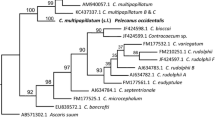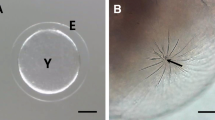Summary
The gemmule coat of Spongilla lacustris is histologically single-layered in the gemmules studied in this work. This single layer is comparable to the classically described internal “chitinous” membrane of Leveaux (1939). It has been found to contain collagen with an axial period in electron micrographs of about 120 Å and is bounded internally by a thin dense layer which is separate from the internal gemmular cells, and which may be chitinous.
Gemmules of this sponge studied during March to June of 1973 respond to 230 mOsmolar solutions of small molecules by: 1. undergoing no change, in which case the substances are freely permeable to the gemmule coat and cells; 2. displaying shrinkage of the cell mass, in which case the substances are permeable to the coat but relatively impermeable to the cells; 3. displaying folding of the coat and cell mass shrinkage because the substances are relatively impermeable to both the coat and the cells; and 4. displaying complete collapse of the gemmule due to impermeability to the coat. The lipid solubility of a substance is directly related to its ability to penetrate the coat. Further, molecular size and charge are also of apparent importance.
Substances which penetrate the coat and remain osmotically active (are not metabolized) inhibit hatching. Low concentrations of sodium chloride (23 mOsmolar) have been demonstrated to reversibly inhibit hatching. Higher concentrations cause irreversible damage at 20° C but have little effect at 4° C, indicating that damage is related to the metabolic level of the cells. Once hatching is stimulated by increased temperature the cells become progressively less sensitive to an increase in osmotically active substances.
Inhibition of gemmule hatching can theoretically occur by: 1. an addition of solutes to the gemmular fluid, or 2. through an increase in concentration of intragemmular solutes by water withdrawal.
Our results raise the question of whether the inhibition of hatching by gemmulostasine, reported by Rasmont (1965) and Rozenfeld (1970, 1971), is due to an osmotic effect rather than to a specific physiological one.
Based upon the results reported here and on the work of Zeuthen (1939) and Schmidt (1970) we propose a tight coupling between the intragemmular osmotic pressure and the triggering of hatching (cell division). Any substance which increases intragemmular osmotic pressure to a large enough extent will inhibit hatching. Furthermore, it can be hypothesized that hatching is normally triggered by a decrease in osmotic pressure due to water movement into the gemmule, the movement of solutes out of the gemmule, or to a combination of these.
Similar content being viewed by others
References
Berthold, G.: Untersuchungen über die Histoblastendifferenzierung in der Gemmula von Ephydatia fluviatilis. Z. wiss. Mikr. 69, 227–243 (1969)
Brien, P.: Formation des statoblastes dans le genre Potamolepis: P. symoensi (Brien), P. pechuelii (Marshall), P. schoutedeni (Burton). Bull. Acad. roy. Belg. 53, 573–591 (1967)
Collander, R.: Die Verteilung organischer Verbindungen zwischen Äther und Wasser. Acta Chem. Scand. 3, 717–747 (1949)
Gilbert, J. J., Allen, H. L.: Studies on the fresh-water sponge Spongilla lacustris. Organic matter, pigments and primary productivity. Int. Assoc. Pure Appl. Limnol. (in press, 1973)
Gross, J., Sokal, Z., Rougvie, M.: Structural and chemical studies on the connective tissue of marine sponges. J. Histochem. Cytochem. 4, 227–246 (1956)
Hartman, W. D.: Natural history of the marine sponges of southern NewEngland. Bull. Peabody Mus. Nat. Hist., Yale Univ. 12, 1–155 (1958)
Hirsch, J. G., Fedorko, M. E.: Ultrastructure of human leucocytes after simultaneous fixation with glutaraldehyde and osmium tetroxide and “post fixation” in uranyl acetate. J. Cell Biol. 38, 615–627 (1968)
Jeuniaux, C.: Chitine et chitinolyse, 1. Ed. Paris: Masson 1963
Jorgensen, C. B.: On the gemmules of Spongilla lacustris auct. together with some remarks on the taxonomy of the species. Vid. Medd. dansk Naturhist. Foren. Kbh. 109, 69–79 (1946)
Leveaux, M.: La formation des gemmules chez les Spongillidae. Ann. Soc. roy. Zool. Belg. 70, 53–96 (1939)
Lewis, J. C., Snell, N. S., Burr, H. K.: Water permeability of bacterial spores and the concept of a contractile cortex. Science 132, 544–545 (1960)
Lillie, R. S.: Increase of permeability to water following normal and artificial activation in sea urchin eggs. Amer. J. Physiol. 40, 249–266 (1916)
Rasmont, R.: The physiology of gemmulation in fresh-water sponges. Symp. Soc. Study Develop. Growth 20, 3–25 (1962)
Rasmont, R.: Existence d'une régulation biochemique de l'éclosion des gemmules chez les Spongillides. C.R. Acad. Sci. (Paris) 261, 845–847 (1965)
Rasmont, R.: Chemical aspects of hibernation. In: Florkin, M., Scheer, B. T., Eds., Chemical zoology, Vol. II, p. 65–77. NewYork: Academic Press 1968
Rozenfeld, F.: Inhibition du développement des gemmules de Spongillides: spécificité et moment d'action de la gemmulostasine. Arch. Biol. (Liege) 81, 193–214 (1970)
Rozenfeld, F.: Effects de la perforation de la toque des gemmules d'Ephydatia fluviatilis (Spongillides) sur lour développement ultérieur en présence de gemmulostasine. Arch. Biol. (Liege) 82, 103–113 (1971)
Ruthmann, A.: The fine structure of RNA-storing archeocytes from gemmules of fresh-water sponges. Quart. J. micr. Sci. 106, 99–114 (1965)
Schmidt, I.: Etude préliminaire de la differentiation des théocytes d'Ephydatia fluviatilis L. extraits mécaniquement de la gemmule. C. R. Acad. Sci. (Paris) 271, 924–927 (1970)
Simpson, T. L., Gilbert, J. J.: Gemmulation, gemmule hatching, and sexual reproduction in fresh-water sponges. I. The life cycle of Spongilla lacustris and Tubella pennsylvanica. Trans. Amer. micr. Soc. 92, 422–433 (1973)
Sussman, A. S., Halvorson, H. O.: Spores their dormancy and germination, 1. Ed. New York: Harper and Row 1966
Zeuthen, E.: On the hibernation of Spongilla lacustris (L.). Z. vergl. Physiol. 26, 537–547 (1939)
Author information
Authors and Affiliations
Additional information
This work was supported by a grant from the National Science Foundation (GB-37775) to T. L. S.
Rights and permissions
About this article
Cite this article
Simpson, T.L., Vaccaro, C.A. & Sha'afi, R.I. The role of intragemmular osmotic pressure in cell division and hatching of gemmules of the fresh-water sponge Spongilla lacustris (Porifera). Z. Morph. Tiere 76, 339–357 (1973). https://doi.org/10.1007/BF00281816
Received:
Issue Date:
DOI: https://doi.org/10.1007/BF00281816




